Spiny leaf insects (a type of phasmid or stick insect) make cool & easy pets for kids. Would also make a great classroom pet!
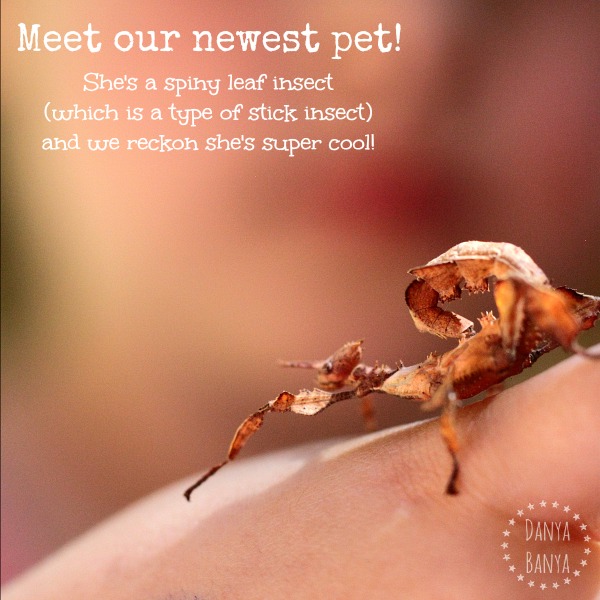 Depending on the exact type, and where you come from, phasmids are also called stick insects, stick-bugs, walking sticks or ghost insects. (Most Australians would call them stick insects, even though these ones are technically leaf insects. We call them phasmids in our household because I want my kids to become familiar with both terms.)
Depending on the exact type, and where you come from, phasmids are also called stick insects, stick-bugs, walking sticks or ghost insects. (Most Australians would call them stick insects, even though these ones are technically leaf insects. We call them phasmids in our household because I want my kids to become familiar with both terms.)
The phasmids in these first few photos are girls. You can tell they are girls, because they have small (harmless) spikes along their back and tail. When they grow a bit bigger, they’ll develop small superficial wings (but they’ll never be able to fly).
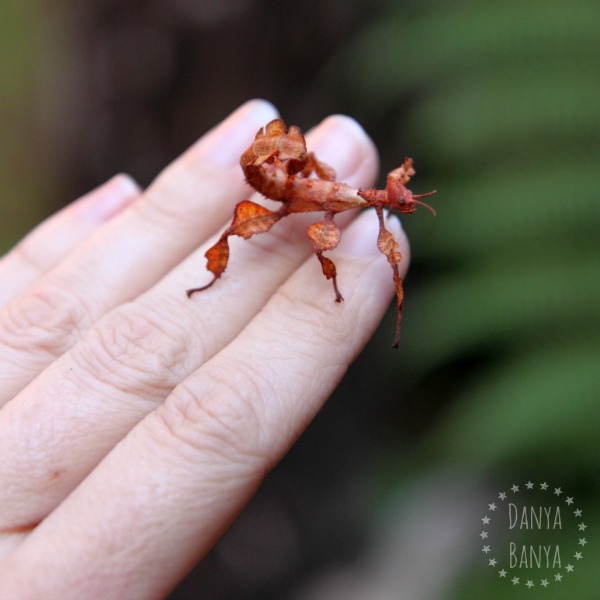
My toddler Bee is holding one of the young male phasmids below. You can tell he’s a male, because his back and tail are straighter and smoother. When he grows up, he’ll develop pronounced wings on his back, and he’ll be able to fly (although not very well).
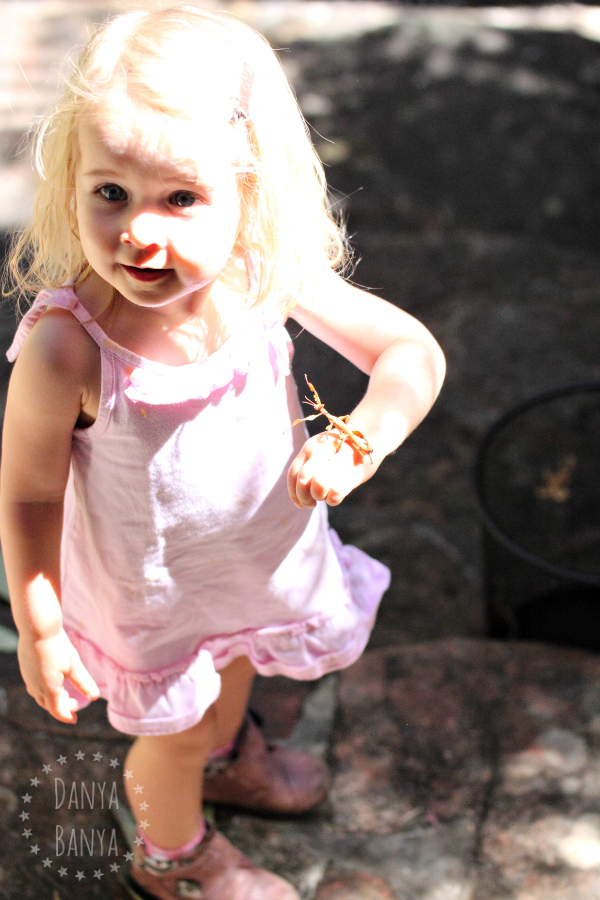
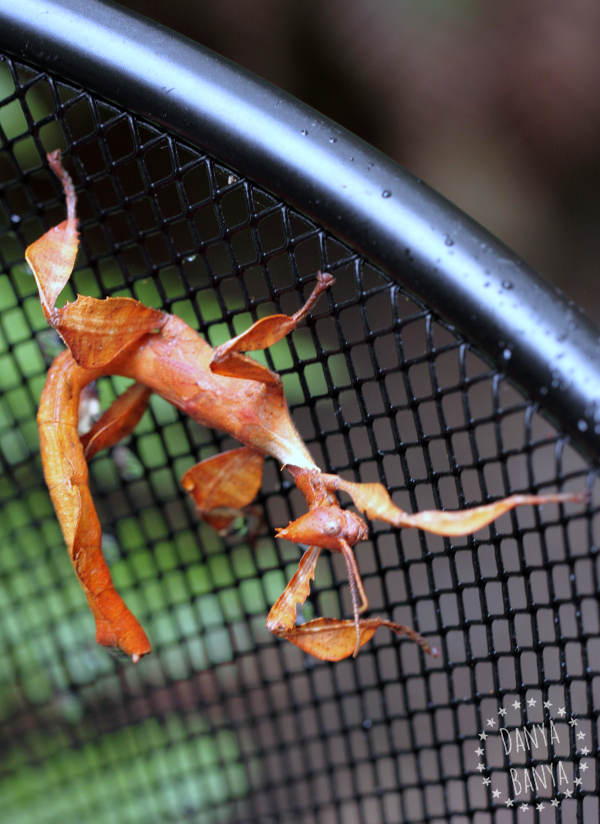
Phasmids are harmless. Their whole defence mechanism is camouflage. When they get scared, they freeze. And if they are really petrified, they start to rock in an attempt to look like a leaf gently swaying in the wind.
At worst, when they walk on you, it tickles. They don’t bite or sting, which makes them an ideal pet for young kids. I brought our phasmids in to JJ’s preschool one morning, and the kids were fascinated!
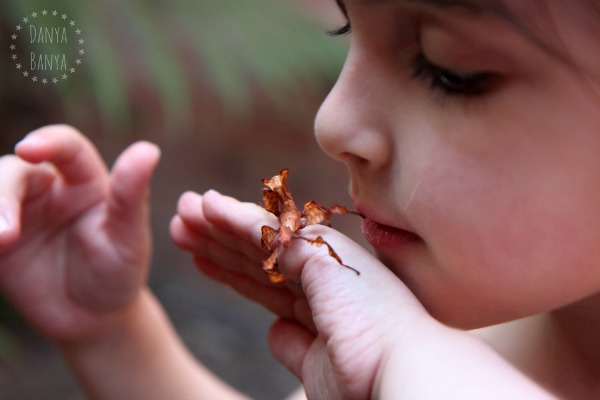
The only tricky thing is that they are rather fragile. You have to teach kids not to use their fingers to pick phasmids up (lest they squish them or tear off a leg), but rather to put out their hand and let the phasmid walk on. Phasmids always want to move forwards and upwards, so if you just put your hand (or any other object) slightly above and in front of them, they’ll generally step up of their own accord. And they are very good at hanging on, and actually prefer to be vertical or upside down.
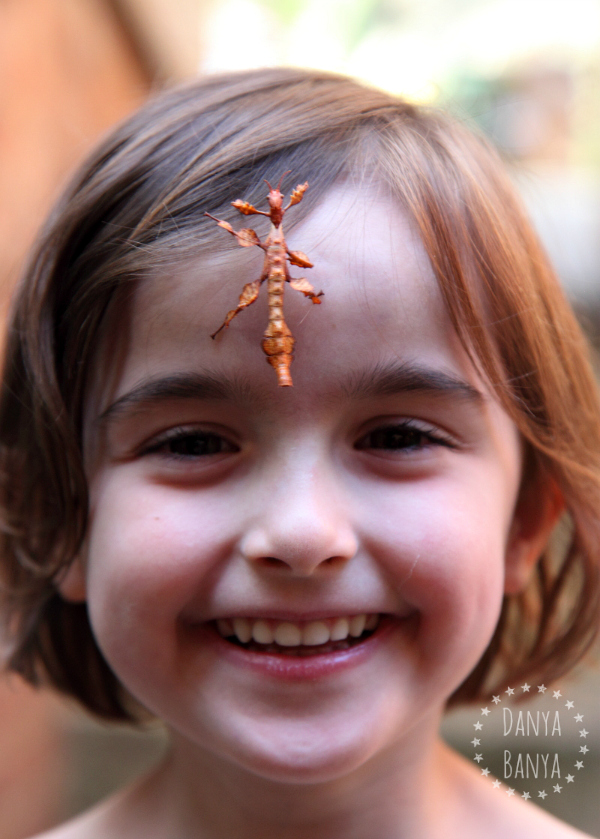
To keep pet phasmids, you need three things: food, shelter, and water.
1. Phasmid food
We feed our phasmids a small branch of fresh gum leaves from a eucalyptus tree. (I can often be found walking with a pair of secateurs sticking out of my back pocket, just in case we happen to pass a gum tree with low hanging branches). I try to choose branches that have a mix of young and old leaves, and if possible, I try to include some from different sources.
The eucalyptus branches need to be put into a vase with a very narrow neck. We use a recycled capers jar because it is so tall and thin. There should be enough water inside the vase to keep the gum leaves fresh. The opening needs to be narrow to prevent the phasmids from drowning.
I try to replace the gum leaves every second or third day, especially if it’s been hot and dry. Topping up the water in the vase keeps the gum leaves fresher, lasting up to a week.
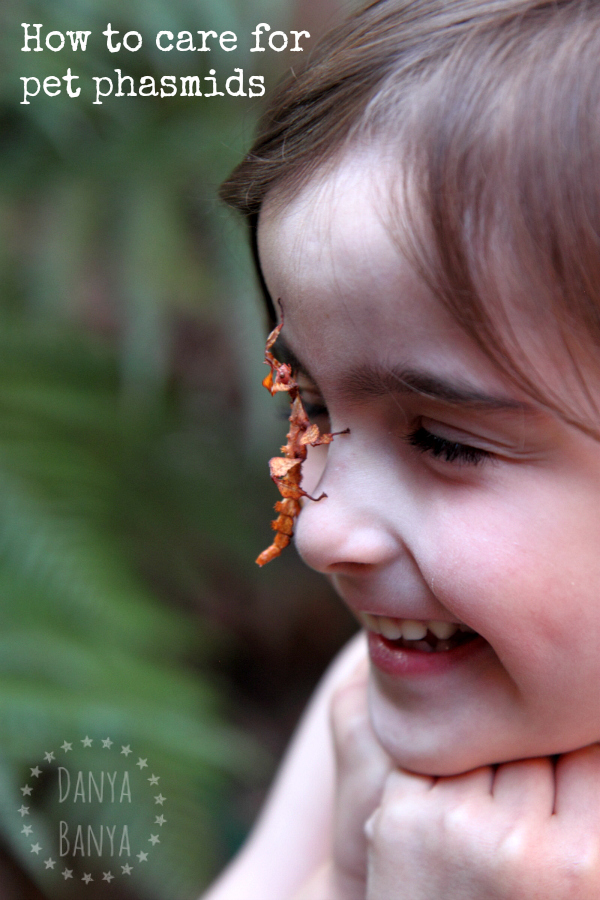
You know what’s really cool? Our phasmids are an orange brownish colour, which is similar to the colour of dried gum leaves – perfect camouflage if you’re planning on living in a eucalyptus tree. I’ve heard that if you feed them rose, wattle tree or bramble leaves, the phasmids become a bright green colour, so that they would blend in better with their surroundings. So awesome!
2. DIY phasmid enclosure
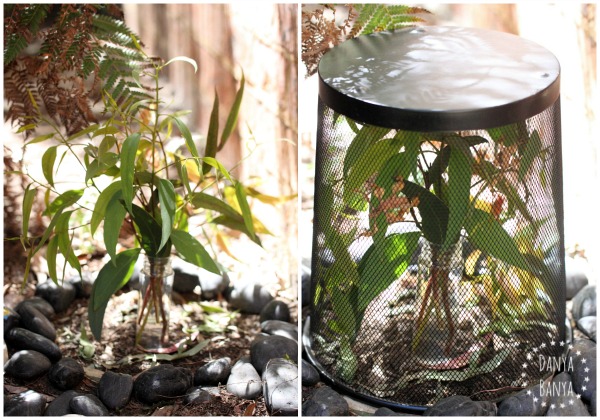
You can see here our capers jar ‘vase’ with water and fresh gum leaves inside. (Tip: if you semi-bury the ‘vase’ it helps prevent it from tipping over.)
Then, all you need is a wire mesh waste paper bin that’s been flipped over. (I bought our bin on sale for less than $5 from Bunnings Hardware. It looks similar to this one*.) The wire mesh needs to be small and strong enough that the phasmids can’t escape, whilst still allowing plenty of airflow. As an extra precaution, I also place large stones around the base of the rubbish bin, to prevent it from accidentally tipping over.
I chose a spot that gets plenty of shade from the harsh Australian sun. The base of the enclosure is the garden bed, with some clean sand for any eggs. Be careful also to choose a spot that won’t be exposed to bug spray or insecticides. (Make sure to ask your neighbours if they plan to do any spraying too).
To change the leaves, I simply pick up the waste paper bin. Most of the phasmids stay stuck to the underside, and the rest are easily transferred. I put the waste paper bin to one side (still upside down), replace the leaves and water, and then put the bin (with the phasmids attached) back over the top.
This waste paper bin enclosure will suffice while the phasmids are still young, but eventually you will need to upgrade to a taller option. I’m in the middle of designing a taller enclosure at our place right now. (I’ll show you pics when it’s finished).
3. How do phasmids drink?
As I eluded above, phasmids don’t drink from large pools of water, and young phasmids can actually drown, so please don’t put a water bowl in your phasmid enclosure. Instead, simply spray your phasmids (through the wire mesh), and the phasmids will drink tiny droplets of water from the wet leaves.
This is a job that toddlers and preschoolers can definitely help with. At our place, the phasmid enclosure is right outside our front door, and the kids give them a quick spray every time we walk past. We keep a spray water bottle next to the enclosure for this purpose. Bonus that spraying water is actually a great hand muscle work out for tiny hands. (Tip: please make sure it’s a new spray water bottle, and that it doesn’t have any previous cleaning solution residue!)
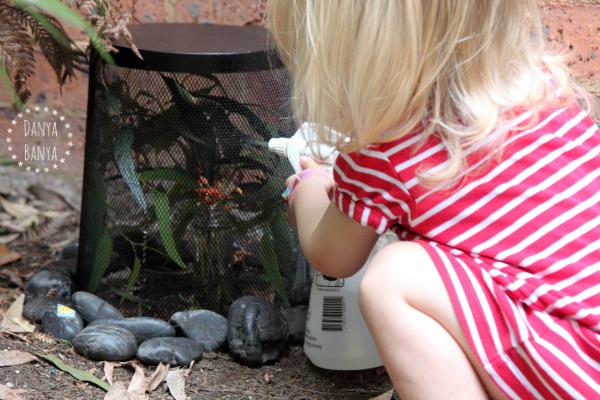
One of the cool things about female phasmids, is that they are able to produce fertile eggs without a mate. They can effectively clone themselves (called parthenogenesis), however all the eggs in this case will produce female babies. (If a female is able to find a male to mate with, only then will the eggs be a mix of male and female).
We haven’t had any babies yet, but I’m hoping that we will soon, as our largest female is now mature.
When the babies hatch, they are similar in shape to their adult form, as they don’t go through a larvae stage like other insects. As they grow, they shed their old skeleton (exoskeleton). Phasmid exoskeleton is really cool for kids to study!
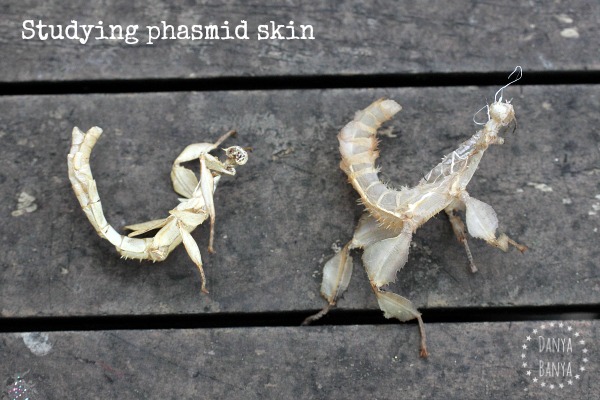
On the left is the exoskeleton of a juvenille male. You can see long thin wings emerging. On the right is the exoskeleton of a juvenille female.
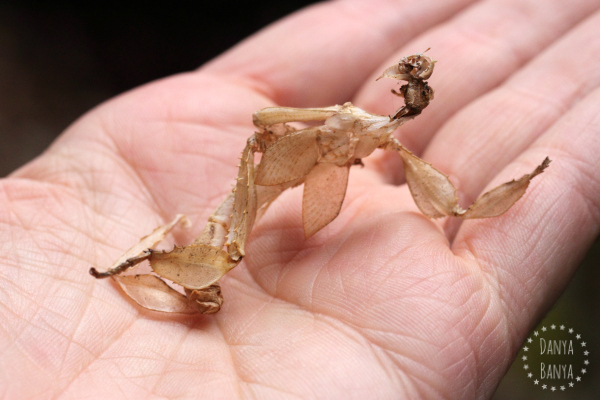
This is the exoskeleton of a maturing female. You can see the emergence of two short (ineffectual) wing stubs on her upper back.
Our largest female phasmid is mature enough to produce eggs, and I’m super excited about the prospect of little babies in the near future!
For more information:
- Care of Stick Insects by The Australian Museum is a great information source for keeping phasmids in a home or classroom environment.
- Phasmatodea on Wikipedia has a lot of very technical information about phasmids, their anatomy etc.
- ABC’s Creature Features has a Spiny Leaf Insects page with a quick summary on caring for pet phasmids for kids.
- We received our spiny leaf insects from a friend who successfully bred them in her backyard enclosure. But according to the internet you can totally buy some from here.
xxx Danya
* Some of the products we have in Australia are not available internationally, so I’ve added in these (cheeky affiliate) Amazon link to help clarify. An affiliate link means I may earn a (tiny) commission if you make a purchase through my link, without any extra cost to you. It helps to keep this little blog afloat. Thanks for your support.

#
Another awesome post. Thanks for sharing. I'd love to get some for the boys, although I with we had a backyard. 🙂
#
Thanks Carla! I've got friends who keep their phasmids in their kitchen, so a backyard isn't mandatory. (Just be extra careful about spraying things though!)
#
Fascinating! Loved reading about Phasmids! Make sure you post to Kids in Nature! 😉
My recent post Peppermint Mocha
#
Thanks Melissa, and will do!
#
That is crazy interesting! We have a of of stick insects (sorry, Phasmids!) coming into our house around spring time. Really big ones! My little ones are a bit afraid of them but maybe next spring we can keep one around for a little while and learn from them.
My recent post 5 Ways to Play Beyond Gender Stereotypes
#
Awesome! They make really cool pets! Just a tip to double check that yours are phasmids and not praying mantids (you can tell by the shape of the head). Praying mantids would still make really cool pets, but as they eat other insects, you'd need to catch them live food like tiny moths etc.
#
Phasmids, or stick insects. You do have to feed them and clean their enclosures, but you need to do that with anything
.Pet Skin Care
Dog Allergy Shampoo
#
Another awesome post. Thanks for sharing.
#
Thanks!
#
Great post.